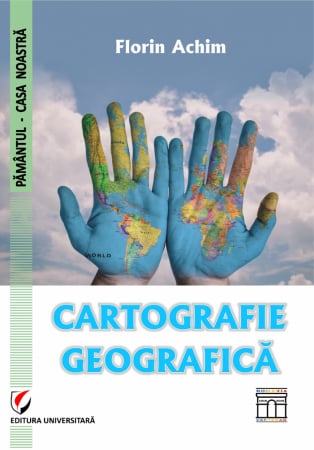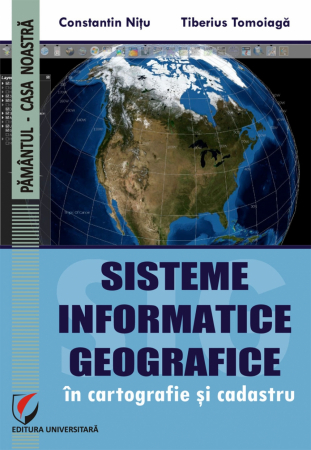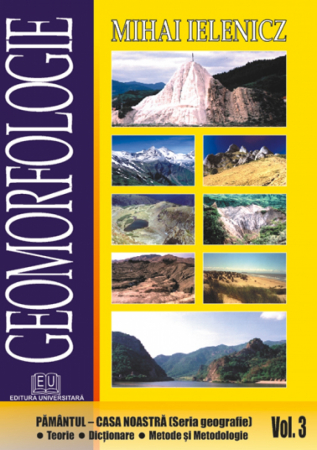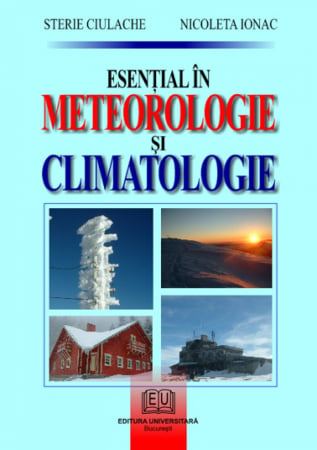Manuscript proposals: [email protected] / 0745 204 115 //// Tracking orders Individuals / Sales: 0745 200 357 / Orders Legal entities: 0721 722 783
ISBN: 978-606-28-0392-6
DOI: 10.5682/ 9786062803926
Publisher year: 2016
Edition: V, revised and added
Pages: 354
Publisher: Editura Universitară
Author: Florina Grecu
Product Code:
9786062803926
Do you need help?
0745 200 357
- Description
- Download (1)
- Authors
- Content
- More details
- Reviews (0)
The frequency and high intensity of the risk phenomena, natural and anthropic, require the permanent revision and completion of the courses with such themes. In addition, scientific debates, research in the field, enrich such complex, theoretical and practical-applied issues of hazards, risks and disasters. Thus, these works are extremely dynamic and subject to reconsideration of concepts, completion of research methods, etc. Here is a brief summary of why the editions are beneficial and I don't think they should be surprising.
In the interval after the publication of the second (in 2004), the third (in 2006), the fourth (in 2009) editions and until now, disasters have taken place on Earth that have resulted in the death of hundreds of thousands of people. and with immense material damage. Also, new approaches have appeared regarding the phenomenology and / or the research by means of computerized technical means of hazards, vulnerability and natural risks. These extreme phenomena have even led to changes in terrestrial morphology. There are events presented in this paper out of the desire to exemplify the terrestrial dynamics as a whole, all catastrophic phenomena and processes having synergistic triggering and development. Understanding correctly the dialectic of these phenomena, we will have the responsibility of educating and training the inhabitants of the Earth in the spirit of maintaining the natural balance, of the thoughtful intervention in the environment.
In the interval after the publication of the second (in 2004), the third (in 2006), the fourth (in 2009) editions and until now, disasters have taken place on Earth that have resulted in the death of hundreds of thousands of people. and with immense material damage. Also, new approaches have appeared regarding the phenomenology and / or the research by means of computerized technical means of hazards, vulnerability and natural risks. These extreme phenomena have even led to changes in terrestrial morphology. There are events presented in this paper out of the desire to exemplify the terrestrial dynamics as a whole, all catastrophic phenomena and processes having synergistic triggering and development. Understanding correctly the dialectic of these phenomena, we will have the responsibility of educating and training the inhabitants of the Earth in the spirit of maintaining the natural balance, of the thoughtful intervention in the environment.
-
Hazarde si riscuri naturale
Download
Prof. univ. dr. FLORINA GRECU (June 1, 1944, Santelec Village, Bihor County) is a graduate of the Faculty of Geography, University of Bucharest (1970), doctor of geography of the University of Bucharest, 1986 (Hartibaciului Basin. Elements of morphohydrology, published in 1992 - Romanian Academy Award). Since 1992 he has been a university teacher. He is currently a university professor. PhD at the Department of Geomorphology - Pedology within the Faculty of Geography, University of Bucharest. She is a member of the editorial board of several specialized publications in the country and abroad, executive director of the Research Center "Land degradation and geomorphological dynamics", evaluator of research contracts C.N.C.S.I.S., general secretary of the Association of Geomorphologists in Romania. Carries out a rich scientific activity on geographical issues, such as: morphohydrological research, risk geomorphological phenomena, slope dynamics, riverbed dynamics, applied geomorphology, surface formations, glaciology, quantitative analysis in dynamic gomorphology, theory, methodology and geographical history, regional geography . He also conducts doctorates, research contracts in the country and in international cooperation programs, teaching internships within the U.E. program. Socrates - Erasmus. Author of several books and over 100 articles published in magazines in the country and abroad.
PREFACE / 3
1. NOTIONS, TERMS, CARTOGRAPHIC REPRESENTATION / 13
1.1. Notions and terms used in the study of extreme phenomena / 13
1.2. Institutionalization of objectives and strategies / 21
1.3. General characteristics of hazards and risks, classifications / 23
1.3.1. The complex and interdisciplinary character / 23
1.3.2. General classification of hazards and risks / 25
1.3.2.1. Natural hazards / 25
1.3.2.2. Social hazards / 27
1.3.2.3. Biological / biogenic hazards / 27
1.3.2.4. Technogenic hazards / 29
1.3.2.5. Hazard classification / 29
1.4. Physical and spatio-temporal characteristics / 30
1.5. Significance of vulnerability indicators / 34
1.5.1. Concepts and notions / 34
1.5.2. Sustainability of life and vulnerability assessment / 37
1.5.3. Vulnerability and disaster risk reduction. Indicators and criteria / 38
1.6. Cartographic representation of hazards and risk / 48
1.6.1. Relevance of risk maps / 48
1.6.2. Types of risk maps / 50
1.7. Historical context of the research. Relationship with applied geomorphology / 56
Verification / 59
2. HAZARDS AND GEOLOGICAL RISKS / 60
2.1. Magmatic phenomena. Volcanoes / 63
2.1.1. Magmatic systems / 63
2.1.2. Morphology of the volcanic apparatus / 65
2.1.3. Types of volcanic activity / 67
2.1.4. Products of volcanic activity / 68
2.1.5. Volcanic eruptions / 70
2.1.6. The impact of volcanic activity on the population / 71
2.1.7. The spread of volcanoes around the world / 75
2.1.8. Prediction of volcanic eruptions / 79
2.2. Seismic phenomena / 79
2.2.1. Elements of an earthquake / 80
2.2.2. Lithology and seismic risk / 82
2.2.3. Genetic types of earthquakes / 83
2.2.4. Earthquake measurement / 85
2.2.5. The impact of seismic phenomena on the population / 86
2.2.6. Earthquakes in Romania / 94
2.2.7. Aspects of earthquake prediction / 96
2.2.8. Measures for self - protection of the population / 98
2.3. Impact on the population - examples / 100
Verification / 119
3. HAZARDS AND GEOMORPHIC AND SOIL DEGRADATION RISKS / 120
3.1. Geomorphic risk phenomena / 121
3.1.1. Definition and classification / 121
3.1.2. Complex processes of falling travel / 124
3.1.2.1. Rolls and free falls / 124
3.1.2.2. Collapses and collapses / 126
3.1.2.3. Avalanches / 126
3.1.2.4. Impact on the population / 132
3.1.3. Displacement and compaction processes / 133
3.1.3.1. Suffocation / 133
3.1.3.2. Settlement / 134
3.1.3.3. Impact on the population / 135
3.1.4. Landslides / 136
3.1.4.1. Definition and social significance / 136
3.1.4.2. The evolution stage and the morphology of the landslide / 137
3.1.4.3. Causes of landslides / 139
3.1.4.4. The evolution of the sliding process / 143
3.1.4.5. Sliding speed / 144
3.1.4.6. Classifications and types of landslides / 145
3.1.4.7. Impact on the population / 152
3.1.5. Slope water process / 153
3.1.5.1. Water erosion not concentrated on slopes / 153
3.1.5.1.1. Erosion by raindrop / 154
3.1.5.1.2. Erosion by film currents / 155
3.1.5.1.3. Factors influencing erosion / 160
3.1.5.1.4. Impact on the population / 164
3.1.5.2. Erosion by concentrated currents (torrential erosion) / 166
3.1.5.2.1. Elementary processes of torrential erosion - ravine / 166
3.1.5.2.2. Classification of deep erosion formations. 169 3.1.5.2.3. The torrential organism (system) / 170
3.2. Other processes of soil degradation risk / 172
3.3. Impact on the population - examples / 175
3.4. Risks caused by collapses and rock falls / 181
3.5. Glacial risks / 182
3.6. Risks due to landslides / 182
3.7. Earthquake - induced risks / 186
Verification / 186
4. ATMOSPHERIC PHENOMENA AND RISK WATER PHENOMENA / 187
4.1. Atmospheric risk phenomena / 187
4.1.1. Definition and classification / 188
4.1.2. Impact on the population / 189
4.1.3. Atmospheric risk phenomena with rapid onset and immediate and direct impact on the population (and / or environment) / 189
4.1.3.1. Tropical cyclones / 189
4.1.3.1.1. Definition and genesis / 193
4.1.3.1.2. Cyclonal phenomena with direct impact on the population and / or the environment / 200
4.1.3.2. Tornadoes (A. Tiscovschi, F. Grecu) / 200
4.1.3.2.1. Definition and genesis / 202
4.1.3.2.2. Impact on the population / 206
4.1.3.3. Thunderstorms, lightning, showers, hail (F. Grecu, A. Tiscovschi) 206 4.1.3.3.1. Definition and genesis / 210
4.1.3.3.2. Impact on the population / 211
4.1.3.4. Viscolul (F. Grecu, A. Tiscovschi) / 211
4.1.3.4.1. Definition and genesis / 214
4.1.3.4.2. Impact on the population / 216
4.1.4. Atmospheric risk phenomena with slow onset and impact on the population (and / or the environment) / 216
4.1.4.1. Atmospheric risk phenomena characteristic of the cold season (F. Grecu, A. Tiscovschi) / 216
4.1.4.1.1. Definition and genesis (frostiness and frost, frost, hoar-frost, glazed frost) / 219
4.1.4.1.2. Impact on the population / 220
4.1.4.2. Droughts / 220
4.1.4.2.1. Definition and genesis / 220
4.1.4.2.2. Impact on the population / 221
4.1.4.3. Desertification / 221
4.1.4.4. Fog (A. Tiscovschi, F. Grecu) / 221
4.2. Risk water phenomena / 224
4.2.1. Definition and classification / 224
4.2.2. The floods (F. Grecu, I. Zavoianu) / 225
4.2.2.1. The significance of floods as a risk phenomenon / 225
4.2.2.2. Causes of floods / 226
4.2.2.3. Impact on the population and the environment / 233
4.2.2.4. Protective measures / 237
4.2.2.5. Provident measures / 238
4.3. Impact on the population - examples / 239
4.3.1. Risks due to torrents and small rivers / 239
4.3.2. The floods caused by the Tiber in Rome / 240
4.3.3. The Paris Floods, January 21–28, 1910/255
4.3.4. Danube floods in April 2006/257
4.3.5. Floods along the coasts / 264
5. COMPLEX RISK PHENOMENON / 270
5.1. Fires / 270
5.1.1. Hazard in natural fires / 270
5.1.1.1. Phases of the genesis and evolution of a fire / 270
5.1.1.2. Conditioning factors / 271
5.1.1.3. Types of fires / 271
5.1.2. Impact and effects of fires on the environment / 271
5.1.3. Fighting fire / 273
5.1.4. Beneficial natural functions of fires / 274
5.1.5. Fire hazard prevention. Fire management / 274
5.1.6. Perception and adaptation to fire hazard / 275
5.1.7. Fire risk - Case studies / 275
5.1.8. Forest fires in the Tunis region (Rym Klibi, F. Grecu) / 277
5.2. Hydrometeorological phenomena produced on the Siret river between July 24 and August 2008 (Saucesti commune, Bacau county) / 284
5.3. Hydrometeorological phenomena produced in arid climate - Algeria / 287
Verification / 289
6. RECORDS IN DISASTERS / 290
6.1. Year 2008 / 290
6.2. The earthquake in Italy (April 6, 2009) / 295
6.3. Disaster dynamics / 296
7. DICTIONARY OF TERMS / 299
8. DEFINITIONS (AFTER UNISDR, 2009) (ROMANIAN, FRENCH, ENGLISH) / 313
9. ANNEXES / 321
9.1. Arvan morphohydrographic basin. / 321
9.1.1. Vulnerability and imminent risk map / 321
9.2. The legend of the map of current geomorphological processes / 325
9.3. The legend of the risk map / 332
INDEX / 334
BIBLIOGRAPHY / 338
1. NOTIONS, TERMS, CARTOGRAPHIC REPRESENTATION / 13
1.1. Notions and terms used in the study of extreme phenomena / 13
1.2. Institutionalization of objectives and strategies / 21
1.3. General characteristics of hazards and risks, classifications / 23
1.3.1. The complex and interdisciplinary character / 23
1.3.2. General classification of hazards and risks / 25
1.3.2.1. Natural hazards / 25
1.3.2.2. Social hazards / 27
1.3.2.3. Biological / biogenic hazards / 27
1.3.2.4. Technogenic hazards / 29
1.3.2.5. Hazard classification / 29
1.4. Physical and spatio-temporal characteristics / 30
1.5. Significance of vulnerability indicators / 34
1.5.1. Concepts and notions / 34
1.5.2. Sustainability of life and vulnerability assessment / 37
1.5.3. Vulnerability and disaster risk reduction. Indicators and criteria / 38
1.6. Cartographic representation of hazards and risk / 48
1.6.1. Relevance of risk maps / 48
1.6.2. Types of risk maps / 50
1.7. Historical context of the research. Relationship with applied geomorphology / 56
Verification / 59
2. HAZARDS AND GEOLOGICAL RISKS / 60
2.1. Magmatic phenomena. Volcanoes / 63
2.1.1. Magmatic systems / 63
2.1.2. Morphology of the volcanic apparatus / 65
2.1.3. Types of volcanic activity / 67
2.1.4. Products of volcanic activity / 68
2.1.5. Volcanic eruptions / 70
2.1.6. The impact of volcanic activity on the population / 71
2.1.7. The spread of volcanoes around the world / 75
2.1.8. Prediction of volcanic eruptions / 79
2.2. Seismic phenomena / 79
2.2.1. Elements of an earthquake / 80
2.2.2. Lithology and seismic risk / 82
2.2.3. Genetic types of earthquakes / 83
2.2.4. Earthquake measurement / 85
2.2.5. The impact of seismic phenomena on the population / 86
2.2.6. Earthquakes in Romania / 94
2.2.7. Aspects of earthquake prediction / 96
2.2.8. Measures for self - protection of the population / 98
2.3. Impact on the population - examples / 100
Verification / 119
3. HAZARDS AND GEOMORPHIC AND SOIL DEGRADATION RISKS / 120
3.1. Geomorphic risk phenomena / 121
3.1.1. Definition and classification / 121
3.1.2. Complex processes of falling travel / 124
3.1.2.1. Rolls and free falls / 124
3.1.2.2. Collapses and collapses / 126
3.1.2.3. Avalanches / 126
3.1.2.4. Impact on the population / 132
3.1.3. Displacement and compaction processes / 133
3.1.3.1. Suffocation / 133
3.1.3.2. Settlement / 134
3.1.3.3. Impact on the population / 135
3.1.4. Landslides / 136
3.1.4.1. Definition and social significance / 136
3.1.4.2. The evolution stage and the morphology of the landslide / 137
3.1.4.3. Causes of landslides / 139
3.1.4.4. The evolution of the sliding process / 143
3.1.4.5. Sliding speed / 144
3.1.4.6. Classifications and types of landslides / 145
3.1.4.7. Impact on the population / 152
3.1.5. Slope water process / 153
3.1.5.1. Water erosion not concentrated on slopes / 153
3.1.5.1.1. Erosion by raindrop / 154
3.1.5.1.2. Erosion by film currents / 155
3.1.5.1.3. Factors influencing erosion / 160
3.1.5.1.4. Impact on the population / 164
3.1.5.2. Erosion by concentrated currents (torrential erosion) / 166
3.1.5.2.1. Elementary processes of torrential erosion - ravine / 166
3.1.5.2.2. Classification of deep erosion formations. 169 3.1.5.2.3. The torrential organism (system) / 170
3.2. Other processes of soil degradation risk / 172
3.3. Impact on the population - examples / 175
3.4. Risks caused by collapses and rock falls / 181
3.5. Glacial risks / 182
3.6. Risks due to landslides / 182
3.7. Earthquake - induced risks / 186
Verification / 186
4. ATMOSPHERIC PHENOMENA AND RISK WATER PHENOMENA / 187
4.1. Atmospheric risk phenomena / 187
4.1.1. Definition and classification / 188
4.1.2. Impact on the population / 189
4.1.3. Atmospheric risk phenomena with rapid onset and immediate and direct impact on the population (and / or environment) / 189
4.1.3.1. Tropical cyclones / 189
4.1.3.1.1. Definition and genesis / 193
4.1.3.1.2. Cyclonal phenomena with direct impact on the population and / or the environment / 200
4.1.3.2. Tornadoes (A. Tiscovschi, F. Grecu) / 200
4.1.3.2.1. Definition and genesis / 202
4.1.3.2.2. Impact on the population / 206
4.1.3.3. Thunderstorms, lightning, showers, hail (F. Grecu, A. Tiscovschi) 206 4.1.3.3.1. Definition and genesis / 210
4.1.3.3.2. Impact on the population / 211
4.1.3.4. Viscolul (F. Grecu, A. Tiscovschi) / 211
4.1.3.4.1. Definition and genesis / 214
4.1.3.4.2. Impact on the population / 216
4.1.4. Atmospheric risk phenomena with slow onset and impact on the population (and / or the environment) / 216
4.1.4.1. Atmospheric risk phenomena characteristic of the cold season (F. Grecu, A. Tiscovschi) / 216
4.1.4.1.1. Definition and genesis (frostiness and frost, frost, hoar-frost, glazed frost) / 219
4.1.4.1.2. Impact on the population / 220
4.1.4.2. Droughts / 220
4.1.4.2.1. Definition and genesis / 220
4.1.4.2.2. Impact on the population / 221
4.1.4.3. Desertification / 221
4.1.4.4. Fog (A. Tiscovschi, F. Grecu) / 221
4.2. Risk water phenomena / 224
4.2.1. Definition and classification / 224
4.2.2. The floods (F. Grecu, I. Zavoianu) / 225
4.2.2.1. The significance of floods as a risk phenomenon / 225
4.2.2.2. Causes of floods / 226
4.2.2.3. Impact on the population and the environment / 233
4.2.2.4. Protective measures / 237
4.2.2.5. Provident measures / 238
4.3. Impact on the population - examples / 239
4.3.1. Risks due to torrents and small rivers / 239
4.3.2. The floods caused by the Tiber in Rome / 240
4.3.3. The Paris Floods, January 21–28, 1910/255
4.3.4. Danube floods in April 2006/257
4.3.5. Floods along the coasts / 264
5. COMPLEX RISK PHENOMENON / 270
5.1. Fires / 270
5.1.1. Hazard in natural fires / 270
5.1.1.1. Phases of the genesis and evolution of a fire / 270
5.1.1.2. Conditioning factors / 271
5.1.1.3. Types of fires / 271
5.1.2. Impact and effects of fires on the environment / 271
5.1.3. Fighting fire / 273
5.1.4. Beneficial natural functions of fires / 274
5.1.5. Fire hazard prevention. Fire management / 274
5.1.6. Perception and adaptation to fire hazard / 275
5.1.7. Fire risk - Case studies / 275
5.1.8. Forest fires in the Tunis region (Rym Klibi, F. Grecu) / 277
5.2. Hydrometeorological phenomena produced on the Siret river between July 24 and August 2008 (Saucesti commune, Bacau county) / 284
5.3. Hydrometeorological phenomena produced in arid climate - Algeria / 287
Verification / 289
6. RECORDS IN DISASTERS / 290
6.1. Year 2008 / 290
6.2. The earthquake in Italy (April 6, 2009) / 295
6.3. Disaster dynamics / 296
7. DICTIONARY OF TERMS / 299
8. DEFINITIONS (AFTER UNISDR, 2009) (ROMANIAN, FRENCH, ENGLISH) / 313
9. ANNEXES / 321
9.1. Arvan morphohydrographic basin. / 321
9.1.1. Vulnerability and imminent risk map / 321
9.2. The legend of the map of current geomorphological processes / 325
9.3. The legend of the risk map / 332
INDEX / 334
BIBLIOGRAPHY / 338
The frequency and high intensity of the risk phenomena, natural and anthropic, require the permanent revision and completion of the courses with such themes. In addition, scientific debates, research in the field, enrich such complex, theoretical and practical-applied issues of hazards, risks and disasters. Thus, these works are extremely dynamic and subject to reconsideration of concepts, completion of research methods, etc. Here is a brief summary of why the editions are beneficial and I don't think they should be surprising.
In the interval after the publication of the second (in 2004), the third (in 2006), the fourth (in 2009) editions and until now, disasters have taken place on Earth that have resulted in the death of hundreds of thousands of people. and with immense material damage. Also, new approaches have appeared regarding the phenomenology and / or the research by means of computerized technical means of hazards, vulnerability and natural risks. These extreme phenomena have even led to changes in terrestrial morphology. There are events presented in this paper out of the desire to exemplify the terrestrial dynamics as a whole, all catastrophic phenomena and processes having synergistic triggering and development. Understanding correctly the dialectic of these phenomena, we will have the responsibility of educating and training the inhabitants of the Earth in the spirit of maintaining the natural balance, of the thoughtful intervention in the environment.
We believe that we are not wrong in saying that it is time to learn to live with hazards, to know how to defend ourselves from their effects.
In the paper, some chapters were also developed, by completing the phenomenology, by theoretical and illustrative examples (graphics, maps, photographs, etc.).
We thank all our colleagues for the debates on the issue of risks, for the sincere contributions to the enrichment of the knowledge patrimony in the field.
We hope that this paper - Hazards and Natural Risks - will be useful not only to students, but also to all those interested in the interrelationship between nature and man.
University Professor Doctor Dr. Florina GRECU
Department of Geomorphology-Pedology, Geomatics
Geography College
University of Bucharest
In the interval after the publication of the second (in 2004), the third (in 2006), the fourth (in 2009) editions and until now, disasters have taken place on Earth that have resulted in the death of hundreds of thousands of people. and with immense material damage. Also, new approaches have appeared regarding the phenomenology and / or the research by means of computerized technical means of hazards, vulnerability and natural risks. These extreme phenomena have even led to changes in terrestrial morphology. There are events presented in this paper out of the desire to exemplify the terrestrial dynamics as a whole, all catastrophic phenomena and processes having synergistic triggering and development. Understanding correctly the dialectic of these phenomena, we will have the responsibility of educating and training the inhabitants of the Earth in the spirit of maintaining the natural balance, of the thoughtful intervention in the environment.
We believe that we are not wrong in saying that it is time to learn to live with hazards, to know how to defend ourselves from their effects.
In the paper, some chapters were also developed, by completing the phenomenology, by theoretical and illustrative examples (graphics, maps, photographs, etc.).
We thank all our colleagues for the debates on the issue of risks, for the sincere contributions to the enrichment of the knowledge patrimony in the field.
We hope that this paper - Hazards and Natural Risks - will be useful not only to students, but also to all those interested in the interrelationship between nature and man.
University Professor Doctor Dr. Florina GRECU
Department of Geomorphology-Pedology, Geomatics
Geography College
University of Bucharest
If you want to express your opinion about this product you can add a review.
write a review

6359.png)
![Hazards and Natural Risks [1] Hazards and Natural Risks [1]](https://gomagcdn.ro/domains/editurauniversitara.ro/files/product/large/hazarde-si-riscuri-naturale-650-943923.jpg)














